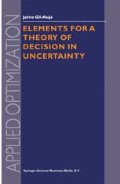Abstract
When attempting to find the mechanism of the brain of a living being that is capable of bringing to light the most elemental symptom of intelligence, one must surely pay a great deal of attention to the concept of relation. If a domestic animal is accustomed to eat from a certain container, when it hears the particular noise it makes then it will run towards it: it associates and relates, noise-food. From our very earliest childhood we are taught to improve the devices that lead to relation, by developing in the very smallest, the most diverse kinds of connections: between things and colours, effort and prizes, between certain objects and others,... Teachers are very much aware of the importance of relation in the mental progress of a child. And the truth of the matter is that whatever activity is carried on, it is difficult to imagine any reasoning whatsoever in which relations are not present as a very basic support.
Access this chapter
Tax calculation will be finalised at checkout
Purchases are for personal use only
Preview
Unable to display preview. Download preview PDF.
References
See, for example, in this respect Kaufmann, A and Gil Aluja, J: Grafos neuronales para la economla y gestion de empresas. Ed. Pirdmide. Madrid 1995, page 18.
We have specifically place zeros when µ = 0 with the object of making obvious the custom of doing without the arcs in this case, when resorting to the arrow form representation.
In these types of square matrices we are going to use, for easy and visual effectiveness, the type of arrow form representation we show in this case.
We are not referring here to the case in which the intensity coincides in the relation a, with ai with that of the relation al with a,.
It would be advisable not to confuse “class of similarity” with “class of equivalence” or “strongly connected sub-graph”. In fact, for matrix [B], the sub-set formed byy fat, a4, as) is a class of equivalence but not a class of similarity, while in [B] it is one thing and the other.
Here we disregard the normal rules used for converting a fuzzy relation into a boolean relation, since we are only attempting to illustrate, by an example, the concept of pre-order.
We repeat the necessity to distinguish between similarity and equivalency class. The formation of maximum strongly connected sub-graphs or equivalency classes will be dealt with later on.
See in this respect Kaufmann, A, and Gil Aluja, J.: Nuevas técnicas para la direccidn estratégica. Publicaciones Universidad de Barcelona, Barcelona, 1991, page 117–147.
The development of the relations of incidence has permitted the formulation of the notion of forgotten effect. Anyone interested in this subject can consult: Kaufmann, A. and Gil Aluja, J.: Modelos para la investigaciOn de efectos olvidados. Ed Milladoiro. Santiago de Compostela, 1988.
Kaufmann, A. and Gil Aluja, J.: Modelos para la investigaciOn de efectos olvidados. Ed. Milladoiro. Santiago de Compostela, 1988.
Kaufmann, A. and Gil Aluja, J.: Técnicas operativas de gestion para el tratamiento de la incertidumbre. Ed. Hispano Europea. Barcelona 1987, pages 147–148.
Author information
Authors and Affiliations
Rights and permissions
Copyright information
© 1999 Springer Science+Business Media Dordrecht
About this chapter
Cite this chapter
Gil-Aluja, J. (1999). Relations. In: Elements for a Theory of Decision in Uncertainty. Applied Optimization, vol 32. Springer, Boston, MA. https://doi.org/10.1007/978-1-4757-3011-1_2
Download citation
DOI: https://doi.org/10.1007/978-1-4757-3011-1_2
Publisher Name: Springer, Boston, MA
Print ISBN: 978-1-4419-4817-5
Online ISBN: 978-1-4757-3011-1
eBook Packages: Springer Book Archive

